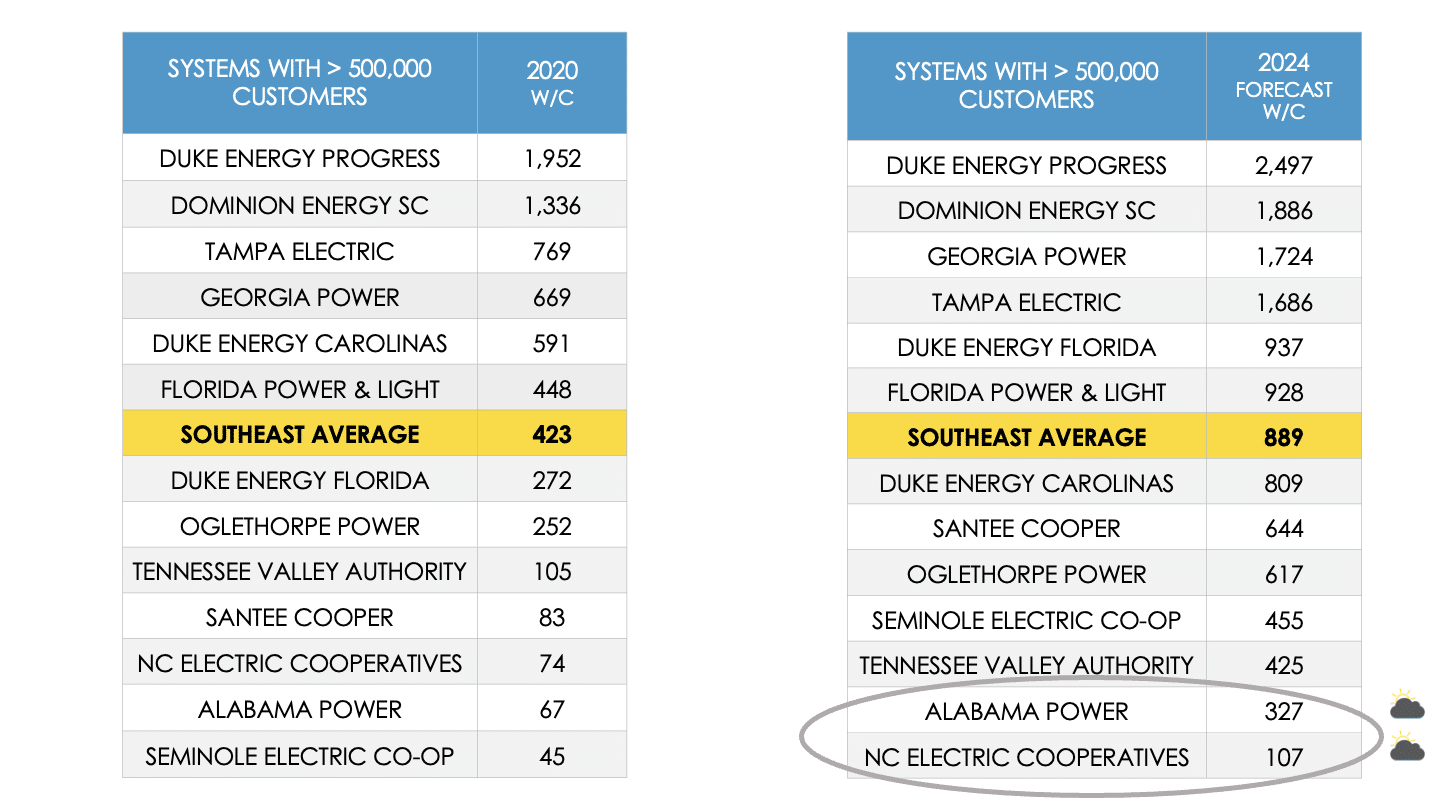The laggards in our "Solar in the Southeast" reports are labeled as 'SunBlockers.' In our fourth annual report, Alabama Power and the North Carolina Electric Cooperatives bear that moniker.
Bryan Jacob | July 6, 2021 | Solar, Utilities
Download the Report
Watch the Report Webinar
Read the Report Blog Series
Our dubious ‘SunBlocker’ distinction applies to the large utility systems, with customers over 500,000, whose plans for the next four years (through 2024) will leave them with a watts per customer (W/C) solar ratio below the region average from last year of 423 W/C.
For reference, our third “Solar in the Southeast” report published in June 2020, had a W/C ratio for 2019 of 325 W/C.
Let’s see which utilities are no longer SunBlockers, and which joined or remained on the list.
New and Returning SunBlockers
Alabama Power has joined the North Carolina Cooperatives with the SunBlocker designation. This is the third consecutive year the North Carolina Electric Cooperatives have graced the SunBlocker list. At least they’re consistent.
The Southeast average from 2020 was 423 watts per customer. The forecast for 2024 shows Alabama Power only supplying 327 watts per customer. Similarly, the North Carolina Electric Cooperatives are only anticipated to offer a paltry 107 watts per customer in 2024. Members of the respective co-ops should insist their utilities expand their clean energy opportunities.
It is noteworthy that some of the individual co-ops in North Carolina do offer more solar to their customers than others. More favorable examples include Halifax EMC and Tri-County EMC. See Appendix B of our report.
Since the plans for these two utility systems lack sufficient ambition to achieve even last year’s region average, we designate them as SunBlockers. This is best illustrated by the companion tables from page 6 of the report.

Why did Alabama Power join the SunBlockers list?
Alabama Power received Public Service Commission (PSC) approval for 500 MW of solar back in 2015. However, thus far, only about 20% of that capacity has been developed. In 2019, Alabama Power included 400 MW of solar in its request to build a fossil gas plant, buy a fossil gas plant, and contract for output from another fossil gas plant. We at SACE identified this as utility double-speak at the time, as it appeared misleading for Alabama Power to ask the Commission for 400 MW of solar when it already had approval for 400 MW that wasn’t commissioned yet.
To anyone paying attention, it wasn’t really a surprise when the Commission approved the fossil gas proposals and deferred a decision on the solar capacity back to the original docket where the existing approval was granted. Incidentally, that 2015 PSC order was clear that “After six (6) years from the date of the Commission’s order if any of the authorized 500 megawatts has not been exercised, the certificate authorization for that unexercised capacity will expire.” The Commission also established “that no more than 160 MW can be submitted and approved under the 500 MW certificate authority in any given calendar year.” With less than three months left on the clock, it is clear that Alabama Power will not fulfill its original solar plans and now finds itself joining the SunBlocker category.
Not only is Alabama Power failing to incorporate even moderate amounts of solar into its utility-scale planning, but this utility also imposes a punitive fee on distributed solar customers which constrains that market segment, as well. This egregious policy has been well-documented and also earned Alabama Power the “Solar Braker” designation in a report from Southern Environmental Law Center.
No longer SunBlockers, but not exactly leaders either
Two of the utilities that have previously been designated SunBlockers for all three previous “Solar in the Southeast” reports, Tennessee Valley Authority (TVA) and Seminole Electric, emerged, just slightly, from that dishonorable category at 425 W/C and 455 W/C respectively.
Check out last year’s full SunBlocker list.
The TVA is now forecast to achieve 425 watts per customer in 2024 – just above the 2020 average for the region of 423 W/C. Much of the reason for TVA dropping off the SunBlocker spot for the first time in four reports, can be attributed to the Knoxville Utilities Board’s two major solar announcements totaling 502 MW – landing the East Tennessee utility a SunRiser spot in our report this year.
Similarly, the solar contract for Seminole Electric will be fully enacted by 2024 and will raise its solar ratio to 455 W/C. Therefore the designation no longer applies to this historic SunBlocker.
Stay tuned for more blogs in the series and find more report resources below.
Download the Report
Watch the Report Webinar
Read the Report Blog Series
#SSR2021